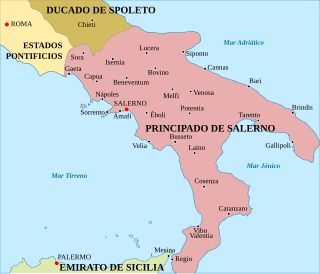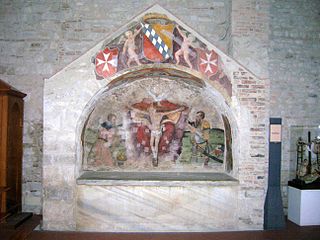Henry (died probably 21 December 1102 [1] ) was the Count of Monte Sant'Angelo, with his seat at Foggia, from November 1081.
He was the second son of Robert, Count of Lucera, and Gaitelgrima, daughter of Guaimar IV of Salerno. The identity of his father is disputable. He was either the same person as a Robert who was Count of Devia between 1054 and 1081 or he was a son of Asclettin, Count of Aversa, and brother of Richard I of Capua. Henry's mother is known from one of his documents of 1098 which calls Guaimar IV avi mei.
Henry had an elder brother named Richard who served as count between 1072 and 1077 and was dead by March 1083. He also had a younger brother named William and a sister named Gaita who married Rao of Devia.
Henry was the perhaps the same Henry as rebelled between 1079 and 1080 against Robert Guiscard. He certainly participated in the revolt in Apulia in 1081, on the eve of the Guiscard's first Balkan campaign. This revolt was led by Geoffrey, Count of Conversano, and supported by Alexius I Comnenus but quashed by 1083. Nonetheless, Henry had, in during the insurrection, transferred his allegiance to the Byzantine Empire. Between March 1083 and June 1086, he dated his charters by the reign of Alexius I.
In June 1087, Henry appeared at the side of Roger Borsa, apparently having patched up his differences with the Hauteville Dukes of Apulia. He maintained a good rapport with Borsa. In 1088, he was present at the duke's making of a donation to SS Trinità di Venosa and he made his own in 1089. Henry was a prolific donor to Benedictine monasteries, endowing, besides Venosa, Montecassino, La Trinità della Cava, S. Sofia di Benevento, and S. Giovanni in Lamis.
For every year between 1089 and 1096, save 1091, all his documents use imperial dating. During this era, his territorial authority reached its maximum extent stretching from Lucera to Fiorentino, Vaccarizza, and Siponto, along the coast of the Gargano from Vieste to Rodi and Cagnano and from San Nicandro to the promontory, Rignano, and the Capitanate.
In 1098, he donated land outside the walls of Monte Sant'Angelo to his uncle, John, Abbot of Curte, son of Guaimar IV, for the construction of a hospice. This hospice was approved by Pope Paschal II in January 1100. In April 1101, the hospice came under Cassinese supervision.
Henry died not long after and was succeeded by his brother William. In October 1104, Roger Borsa besieged William and expelled him, abolishing the county. In 1086, Henry had married Adelicia (died before 1096), daughter of Roger I of Sicily, but she gave him no descendants.

Robert Guiscard, also referred to as Robert de Hauteville, was a Norman adventurer remembered for his conquest of southern Italy and Sicily in the 11th century.

Roger I, nicknamed "Roger Bosso" and "Grand Count Roger", was a Norman nobleman who became the first Grand Count of Sicily from 1071 to 1101.
Sikelgaita was a Lombard princess, the daughter of Prince Guaimar IV of Salerno and second wife of Duke Robert Guiscard of Apulia. Her heritage made her a vital asset to Robert's governance in Southern Italy, legitimizing his reign and that of his successors. Sikelgaita frequently accompanied Robert on campaigns and is noted for leading troops in battle. She continued to be a significant source of support for her primary heir, Roger Borsa, and remained actively involved in politics until her death.

Roger Borsa was the Norman Duke of Apulia and Calabria and effective ruler of southern Italy from 1085 until his death.

Drogo of Hauteville was the second Norman Count of Apulia. He led the Normans of Southern Italy after the death of his brother, William Iron Arm.

Humphrey of Hauteville, also nicknamed Abelard, was the third Norman Count of Apulia. He succeeded his brother Drogo.

Guaimar IV was Prince of Salerno (1027–1052), Duke of Amalfi (1039–1052), Duke of Gaeta (1040–1041), and Prince of Capua (1038–1047) in Southern Italy over the period from 1027 to 1052. He was an important figure in the final phase of Byzantine authority in the Mezzogiorno and the commencement of Norman power. He was, according to Amatus of Montecassino, "more courageous than his father, more generous and more courteous; indeed he possessed all the qualities a layman should have—except that he took an excessive delight in women."

Jordan I, count of Aversa and prince of Capua from 1078 to his death, was the eldest son and successor of Prince Richard I of Capua and Fressenda, a daughter of Tancred of Hauteville and his second wife, also named Fressenda, and the nephew of Robert Guiscard, duke of Apulia, Calabria, and Sicily. He, according to William of Apulia, "equalled in his virtues both the duke and his father."

Richard II, called the Bald, was the count of Aversa and the prince of Capua from 1090 or 1091. He was under the guardianship of Count Robert of Caiazzo until he came of age in 1093.
William of Hauteville was one of the younger sons of Tancred of Hauteville by his second wife Fressenda. He is usually called Willermus instead of Wilelmus in Latin annals and so is often called Guillerm instead of Guillaume in French.

Abelard of Hauteville was the eldest son of Humphrey, count of Apulia and Calabria (1051–1057), and his Lombard wife, Gaitelgrima of Salerno, also known as Altrude. He was supposed to inherit his father's lands, but Robert Guiscard, his uncle and guardian, who was elected count on Humphrey's death, confiscated them.
Peter I, also known as Petronius, was the first Norman count of Trani. He was one of the most prominent of the twelve leaders of the Norman mercenaries serving Guaimar IV of Salerno. Though it had not yet been conquered from the Byzantine Empire, Peter received Trani in the Normans' division of Apulia made at Melfi in 1042. In that same division his brother Walter received Civitate.
Medieval Amalfi was ruled, in the tenth and eleventh centuries, by a series of dukes, sometimes called dogi, corresponding with the republic of Venice, a maritime rival throughout the Middle Ages. Before the title of Duke of Amalfi was formally established in 957, various patricians governed the territory. Amalfi established itself as one of the earliest maritime trading powers renowned throughout the Mediterranean, considered for two centuries, one of the most powerful of the maritime republics.
Geoffrey the Elder was an Italo-Norman nobleman. A nephew of Robert Guiscard through one of his sisters, he was the count of Conversano from 1072 and the lord of Brindisi and Nardò from 1070, until his death.

The Norman conquest of southern Italy lasted from 999 to 1194, involving many battles and independent conquerors.
William was the Count of Monte Sant'Angelo from 1102 to 1104. He succeeded his brother, Henry, on his death.
The County of Monte Sant'Angelo or Gargano was a large Norman county in southern Italy, covering the Gargano Peninsula and much of the later Province of Foggia. Its comital seat was Monte Sant'Angelo.

The County of Apulia and Calabria, later the Duchy of Apulia and Calabria, was a Norman state founded by William of Hauteville in 1043, composed of the territories of Gargano, Capitanata, Apulia, Vulture, and most of Campania. It became a duchy when Robert Guiscard was raised to the rank of duke by Pope Nicholas II in 1059.
Amicus of Giovinazzo, also Amicus II, was a Norman nobleman and military leader during the Norman conquest of southern Italy. He was the count of Molfetta from 1068 until his death and of Giovinazzo from 1068 until 1073. He came from a prominent family often opposed to the rule of the Hautevilles. In 1067–68, 1072–73 and 1079–80 he took part in rebellions against the Hauteville Duke of Apulia. In 1067 and 1079 he received aid from Byzantium against the duke.
Peter was the Norman count of Lesina in the Duchy of Apulia. He was a son of Walter of Civitate and brother of Amicus of Giovinazzo. Unlike several members of his family, including his brother, he remained loyal to Duke Robert Guiscard throughout the latter's life.